War Memorial Hall c1929

Donald Goldsmith ARMSTRONG
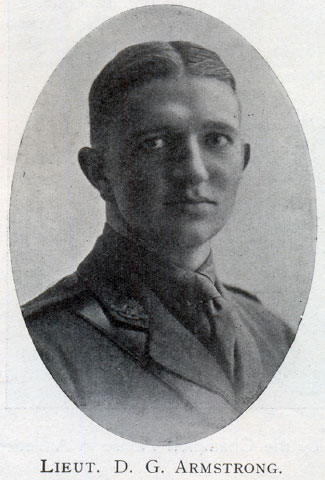
Donald Armstrong was born on 29 June 1893 in Kyneton, Victoria. His parents were Henry James Goldsmith and Emma Isa (née Musgrove) Armstrong. He attended Scotch from 1908 to 1911. He was a boarder and a member of Cadets.
Donald was a bank clerk when he enlisted on 22 June 1915 in Melbourne, Victoria. He served in the 5th Battalion and 21st Battalion with the final rank of 2nd Lieutenant. His Regimental Number was 2932.
Donald died on 9 October 1917 at Ypres, Belgium. He was 24 years of age.
Service record
Donald Armstrong was 6’1” (185 cm) tall on enlistment. In a letter of May 1915 he explained why he was enlisting: ‘I am going to have a try for the war…I think I ought to go, they want all they can get and…I think it is the greatest opportunity for a chap to make a man of himself, those that come back from this war will be men of the right sort that anybody would be proud of’. He was allotted as a Private to the 37th Depot at Seymour, to a ‘Permanent Guard’ and then to reinforcements for the 5th Battalion. This reinforcement group, which included his mate ‘Cardy’ McLean and other Scotchies, sailed for overseas service in September 1915.
By December 1915 he was apparently in Egypt when he expressed frustration at the lack of movement, writing ‘I wish they would let us get to business instead of fooling around here, everybody is sick of it’. In January 1916 he was taken on strength of the 5th Battalion. He disembarked in March with the battalion at Marseille, France. In May 1916 he was transferred to the 5th Battalion’s Lewis Machine Gun Section, as was McLean, and in August was appointed Lance Corporal. In the interval he was involved in very heavy fighting, notably at Pozieres.
His obituary in The Scotch Collegian notes that he faced the trials of the front line with ‘characteristic cheerfulness and optimism.’ In a letter from that time he made light of danger. He described how two sergeants were arguing about whether they were under enemy fire. The issue was decided when ‘a shell whizzed over our heads and exploded about twenty yards from us. That settled the argument, and we played rabbits into the nearest trench.’ In another letter he wrote in light-hearted detail about the great variety of projectiles that the Germans were firing at them: it was a portent of his own fate. He described the fighting at Pozieres, where he and Cardy McLean had been attached to different companies, thus: ‘Our job was to cover the infantry if necessary. I was very lucky to come through without a scratch. I had to take the gun forward. The nearest I had was a bullet through the butt of the gun, which sent me into a shell hole. Finding I wasn’t hit, I carried on. The day following was a very anxious one but our artillery very successfully squashed the counter attack’. His obituary, but not his service record, say he went to machine gun school and on returning discovered that Cardy had been killed. The obituary also mentions leave in London at the end of 1916.
In February 1917 Donald was transferred to the 21st Battalion, for reasons that are unclear. He was selected in March to attend an officers’ course in England, and consequently the following month was at Pembroke College, Cambridge. He described the next three months as the best time he had ever had, composed as they were of ‘tennis, cricket and boating, with a little bit of work in the spare time.’ Nevertheless he came a creditable sixth in the course. He qualified as a 2nd Lieutenant on 3 August 1917 and was posted to General Infantry Reinforcements.
His service record contains an unusual reference here to a ‘crime’, namely ‘breaking off Parade without permission.’ His punishment was a severe reprimand from the CO of the 2nd Australian Division Base Depot. His obituary says he enjoyed another 14 days’ leave, most of it in Scotland. Donald proceeded overseas from Southampton on 18 August 1917 and 10 days later was back with the 21st Battalion. He would be with that battalion for less than two months. He was killed at Broodseinde Ridge during the Third Battle of Ypres, in Belgium, on 9 October 1917.
He was the third Old Scotch Collegian killed as a lieutenant in the 21st Battalion in this battle – after Fred Collins and Harold Harper. Donald’s Red Cross Wounded and Missing file contains several accounts of his death, some of them illegible. It appears that he was killed at night during preparations for an advance. One soldier said he was near a former German pillbox, where Australians were moving up to attack; another says he was at the forming up point; a third that he was going across open country from HQ to the front line. All agree that a shell hit him directly or landed very close to him, killing him instantly. The official history also says that he was killed and another 11 wounded before reaching the jumping-off position. Captain Horace Sandford, his company commander, said of Donald: ‘He was one of my Coy. Officers and I found him a very capable and brave leader, and felt his loss very much.’
In 1924, the body of an Australian soldier was exhumed near Zonnebeke, Belgium. There was a leather case with the body, bearing the letters ‘D.G.A.’ and the numbers ‘2932’ and ‘9/5’ (see below). The letters were Donald’s initials, the numbers his regimental number and reference to the fact that he was in the 9th Reinforcements to the 5th Battalion. His body was thus identified and buried.
His widowed mother Isabel wrote a letter to the authorities thanking them for information on the finding of her ‘dear son’s body’, though she doubted the family would ever see the grave (see below).
Donald Armstrong is buried in the Railway Dugouts Burial Ground (Transport Farm) (Plot II, Row A, Grave No. 10), Zillebeke, Belgium.
Photographs and Documents:
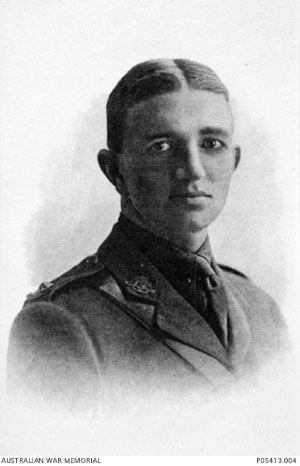
A 1917 studio portrait of 2nd Lieutenant Donald Armstrong
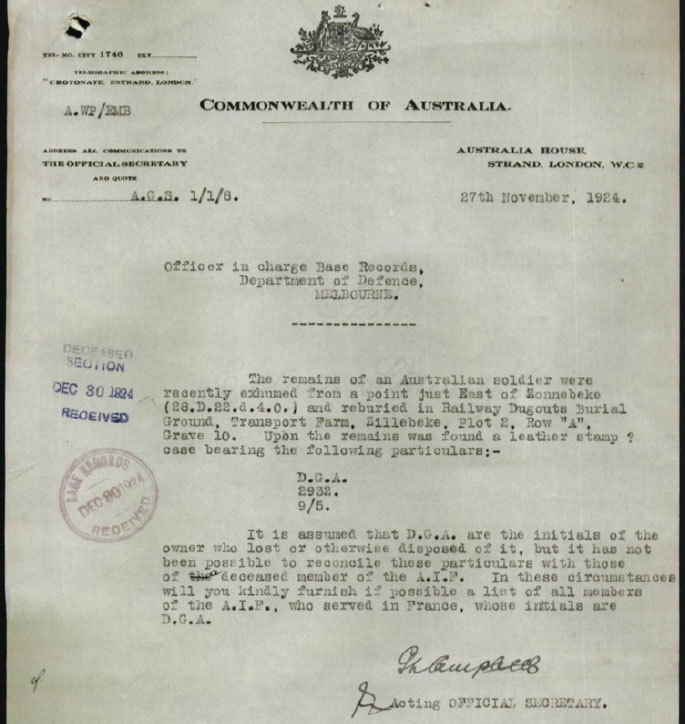
Letter concerning the discovery of the body of ‘D.G.A.’, Donald Armstrong.
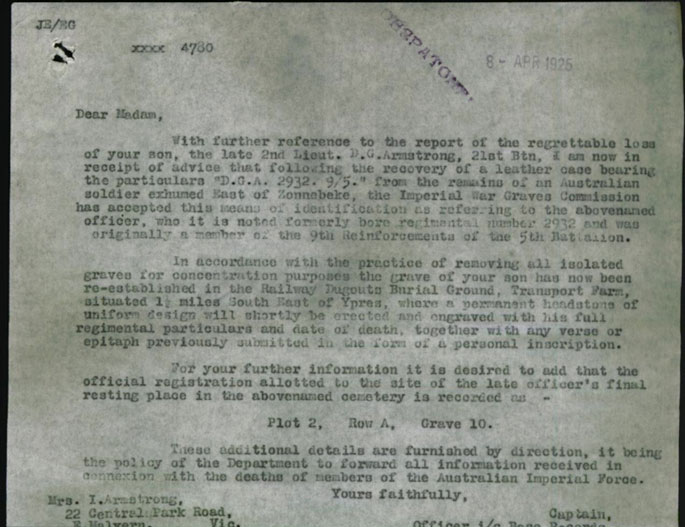
The body is identified as Donald Armstrong and reburied.
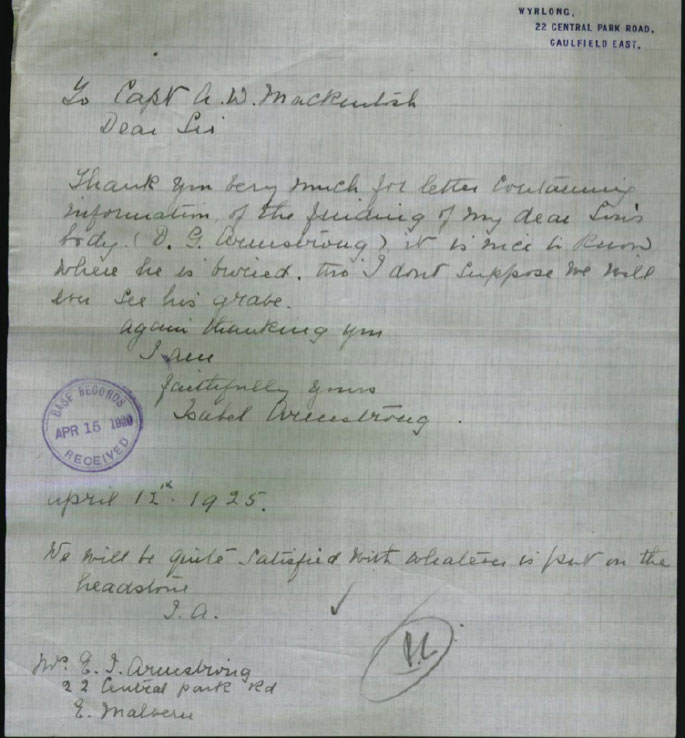
Letter from Donald’s mother concerning the discovery of her ‘dear son’s body’.
Sources:
- Australian War Memorial – Roll of Honour and Red Cross Wounded and Missing file
- Bean, CEW, Official History of Australia in the War of 1914–1918, vol. IV, University of Queensland Press and Australian War Memorial, St Lucia, 1982, p. 897n
- Gammage, Bill, The Broken Years: Australian Soldiers in the Great War, Penguin, Harmondsworth, 1975, pp. 13, 119
- Mishura Scotch Database
- National Archives of Australia – B2455, ARMSTRONG D G
- Scotch Collegian 1917
- The AIF Project - https://www.aif.adfa.edu.au/showPerson?pid=7192


